In this article:
Everyone has some amount of fat under the skin, but the fat in the abdominal region is dangerous. The fat around your waistline releases chemicals that can affect your cholesterol levels and pave the way for various diseases.

Therefore, it is important to manage your weight for better health in the long run.
The Harmful Effects of Excess Belly Fat on Your Overall Health
You have probably heard about the negative effects of carrying extra weight, but did you know there are specific health risks from having too much belly fat? There are, in fact, two different types of belly fat, with one type being especially dangerous to your health.
Subcutaneous fat is the first type of belly fat. It is the fat you can visually see and pinch between your fingers. (1) It, however, is not as dangerous as the second type, called visceral fat.
Visceral fat lies beneath the subcutaneous fat and deeper into your abdomen. It is especially dangerous because of its close proximity to the internal organs. (2) This deeper layer of fat poses a risk for a variety of serious health conditions such as: (2)
- Breast cancer
- Cardiovascular disease
- Colorectal cancer
- Insulin resistance and type 2 diabetes
- High blood pressure
- Sleep apnea
Exercises to Reduce Visceral Belly Fat
Studies have shown that you can help trim visceral fat or prevent its growth with both aerobic activity (such as brisk walking) and strength training (exercising with weights). (3)
1. Aerobic exercise to slim down your belly

Some people resist aerobic activity because of the notion that they must work out hard for an hour or more.
What is true, however, is even 30 minutes of moderate activity done regularly is much more effective than engaging in vigorous exercise less often.
In fact, studies show doing moderate-intensity exercise, such as brisk walking for 30 minutes, six days a week, is enough to prevent more buildup of belly fat. (3)
Moderate-intensity exercise means you are elevating your heart rate to the point where your body begins using the fat for fuel. You can also try jogging, bicycling, swimming, or running.
2. Weight training to reduce abdominal fat
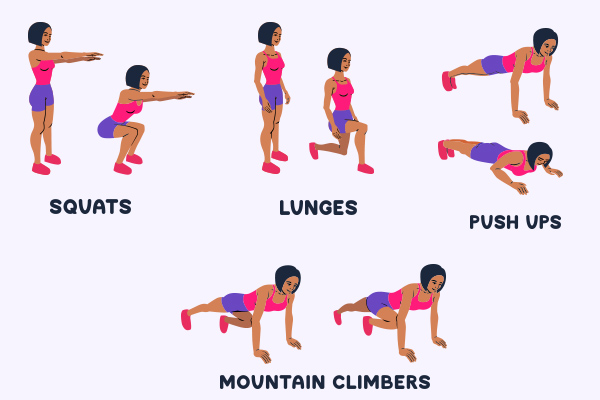
An even greater strategy for losing belly fat is to combine aerobic exercise with weight training. With weight training, you gain lean body weight, which makes your metabolism go up. (4) This allows your body to burn more calories, even when you are at rest.
To get the most success, do body weight exercises that use multiple muscles at once. These help to raise the intensity of the exercise and allow you to burn more calories. (4)
Examples of body weight exercises are:
- Squats
- Lunges
- Push-ups
- Burpees
- Mountain climbers
You can also try the following exercises using a light set of dumbbells for a higher-intensity workout:
- Dumbbell deadlift
- Dumbbell single-arm row
- Dumbbell walking lunge
Tip: Speak to your doctor before starting any new aerobic or weight training routine, as the activity will challenge your heart. And remember to do your resistance training on alternate days to allow your muscle groups to recover between workouts.
Other Exercises That Can Help Tone and Strengthen Your Abdomen
While not highly effective on visceral fat, the following exercises can help you lose weight and strengthen the core abdominal muscles.
1. Crunches
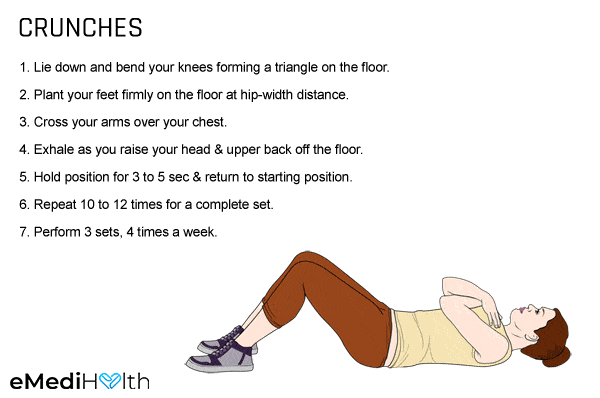
Crunches focus on core abdominal muscles.
- Lie down on an exercise mat, and bend your knees so that your feet lie flat on the ground.
- Put your hands behind your ears.
- Breathe out and lift your upper body slightly with elbows out to the sides.
- Slowly put your shoulders back down while inhaling.
2. Bicycle exercises
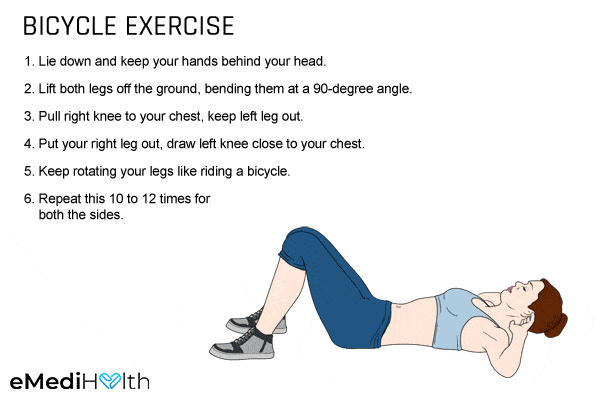
Bicycle exercises are a great option for working your front and side abs.
- Lie down on an exercise mat with hands behind your head.
- Bend your legs and bring your knees over the hips.
- Move your legs in a bicycle motion.
Avoid straining your neck.
3. Leg circles
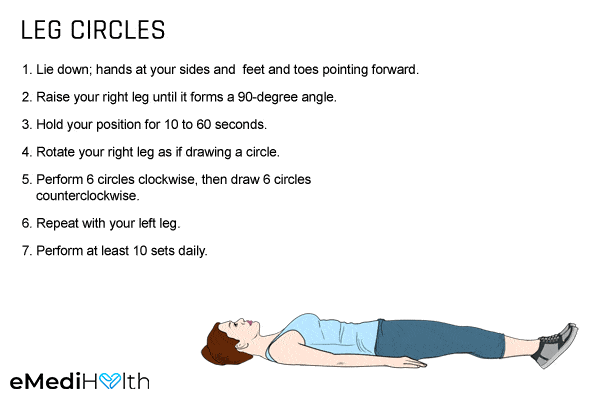
These exercises help strengthen the core and hip joints and also improve balance.
- Raise one leg to your knee height.
- Rotate the leg in a clockwise direction for 10 circles.
- Perform 10 more rotations in a counterclockwise direction with the same leg.
- Switch your leg and repeat the exercise.
4. Hip lifts
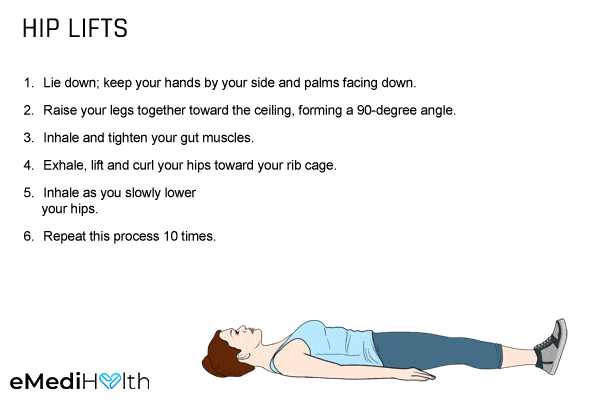
Hip lifts are a great exercise for strengthening the abdominal muscles and glutes.
- Lie down on an exercise mat.
- Inhale and lift your legs perpendicular to the floor.
- Exhale and lift your hips above the ground.
- Slowly lower back your hips while inhaling.
- Repeat 10–12 times.
5. Planks
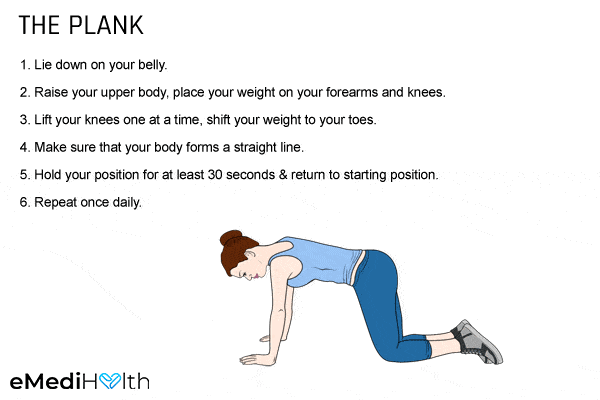
Planks are another excellent core exercise.
- Lie down on your stomach.
- Place your elbows beneath your shoulders and lift your upper body.
- Align the hips with the upper and lower body, like a tabletop.
- Hold the position for 30–40 seconds.
- Drop your knees to the floor and rest.
- Repeat 3 times.
6. Leg drops
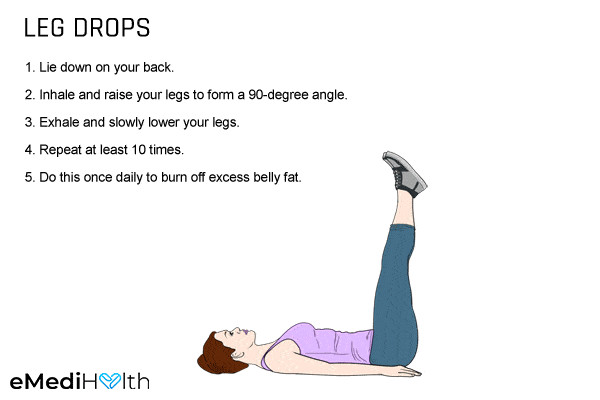
Leg drops help bring stability and strength in the legs.
- Lie down on an exercise mat.
- Raise your legs perpendicular to the ground, with your soles toward the ceiling.
- Lower one leg to the ground gradually.
- Switch legs and repeat for 3–4 sets.
7. Dumbbell squats
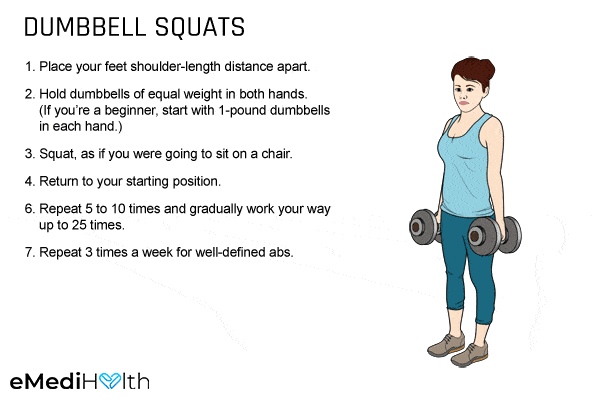
This exercise helps strengthen your thigh and hip muscles.
- Hold the dumbbell in an overhand grip.
- Lift the dumbbells to your shoulder.
- Spread your feet to shoulder width.
- Slowly squat down by bending at your knees with your back straight to get your thighs parallel to the floor.
- Gradually move back up by extending the hips to return to the starting position.
8. Chair pose
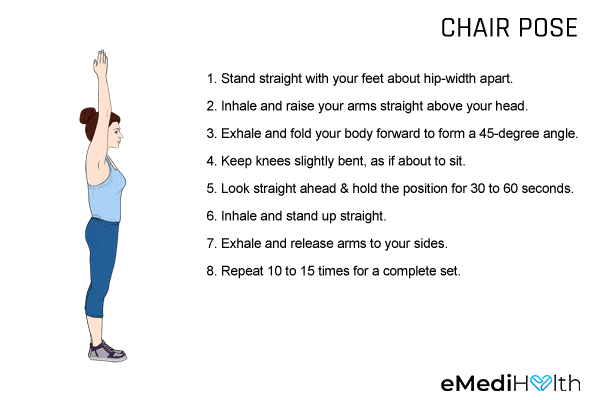
The chair pose is a yoga technique that exercises your abdominal muscles as well as your thighs and glutes.
- Stand straight with your feet apart.
- Bring your hands to the front with palms facing the floor.
- Bend your knees slowly until your posture is similar to one while sitting in a chair.
- Keep your back straight.
- Slowly rise back up while exhaling.
9. Mountain climbers
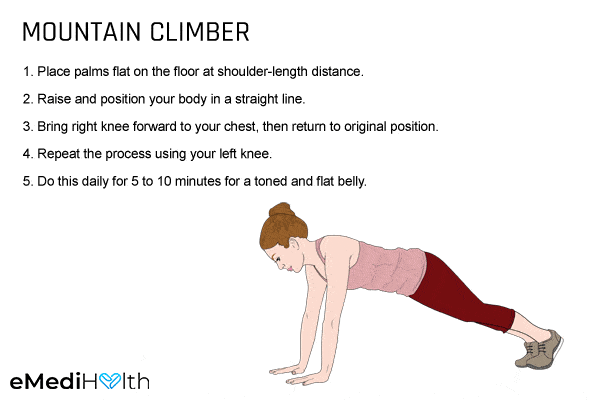
Mountain climbers strengthen the core, build stamina, and burn a ton of calories.
- Place your hands on a bench or chair and go into a plank position.
- Bend your knees at a 45° angle and bring one of them toward your chest.
- Extend the other leg to the back.
- Switch legs and repeat.
10. Flutter kicks
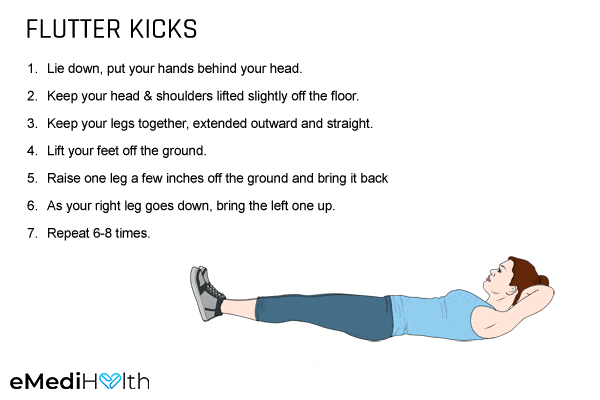
Flutter kicks help reduce your belly fat and can be performed on the floor or in a pool.
- Lie down on a mat and on your back, facing up.
- Place your hands under your hips.
- Lift your right leg slightly above the hip.
- Lift the other leg off the ground.
- Make a flutter kick motion to switch the position of your legs and repeat.
Major Factors That Cause Fat Accumulation Around the Belly
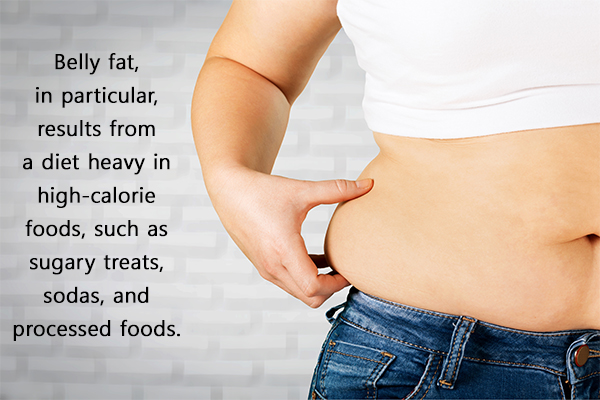
You gain fat around the belly area due to several reasons. The main causes of belly fat are diet and lifestyle choices.
Belly fat, in particular, results from a diet heavy in high-calorie foods, such as sugary treats, sodas, and processed foods. When you combine these dietary choices with little exercise or movement, fat gets stored commonly around the midsection.
Other causes of belly fat, besides a poor diet and lack of exercise, include:
1. Stress
Whenever you encounter stress, your body releases a hormone called cortisol, which helps you deal with stress.
Repeated stress over time can affect your metabolism and cause weight gain. Additionally, if you cope with stress by reaching for comfort foods and/or overeat, the cortisol stores the excess calories around the belly for future use. (5)
2. Age
Belly fat can also occur with age. As you get older, your metabolism changes and slows down, which can cause unwanted weight gain around the waist.
3. Hormones
Women tend to have a higher fat percentage with age than men due to the change in hormones and lower estrogen levels that come with menopause. As the body fat distribution changes with menopause, more fat is directed to the abdomen. (6)
4. Genetics
If you gain weight easily and have a hard time losing it with exercise, it could be due to your genetics. You might be genetically predisposed to weight gain around your belly more than the other parts of your body. (7)
Although you cannot change some factors related to increased belly fat, such as age, gender, or genetics, you can focus on diet and exercise to control unwanted fat around your midsection. (8)
Common Workout Mistakes to Avoid
These are some of the most common mistakes people make while performing weight loss exercises which can undermine their efforts, delay results, and cause injuries along the way:
- Skipping warmup
- Not stretching
- Lack of hydration
- Irregular exercise
- Not cooling down
Why Is It Difficult to Reduce Fat on the Belly?
Belly fat consists of both the subcutaneous padding and visceral fat tissues. The visceral fat envelopes the internal organs and is harder to lose. Moreover, extreme nutritional conditions associated with obesity can lower the rate of lipolysis, making it difficult to burn the fat for energy. (9)
Can Walking Help You Lose Belly Fat?
Yes. A 2014 study concluded that walking exercise is a safe and effective lifestyle strategy against abdominal obesity. (10)
Health Conditions That Lead to Excess Belly Fat
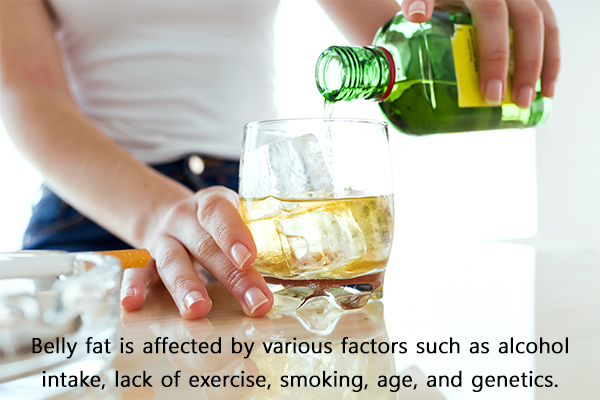
Belly fat is affected by various factors such as alcohol intake, lack of exercise, smoking, age, and genetics. However, obesity is the only health condition that causes belly fat.
Belly fat, on the other hand, can increase the risk of health conditions such as heart problems and cancer.
Some Important Points to Remember When Trying to Reduce Belly Fat
Follow these guidelines to make your weight-loss efforts a success:
- Follow a well-balanced diet and couple it with daily exercise.
- Include warmup and limbering down exercises in your workout routine.
- Avoid alcohol intake or smoking.
- Practice stress management techniques.
Final Word
Losing weight is vital to reduce the visceral fat in your body that contributes to various health problems. Daily exercise and healthy eating are the key to losing weight.
Shedding off 5%–10% of your body fat can greatly reduce the risk of high cholesterol, blood pressure, and blood sugar, making your life healthier.
- Was this article helpful?
- YES, THANKS!NOT REALLY


